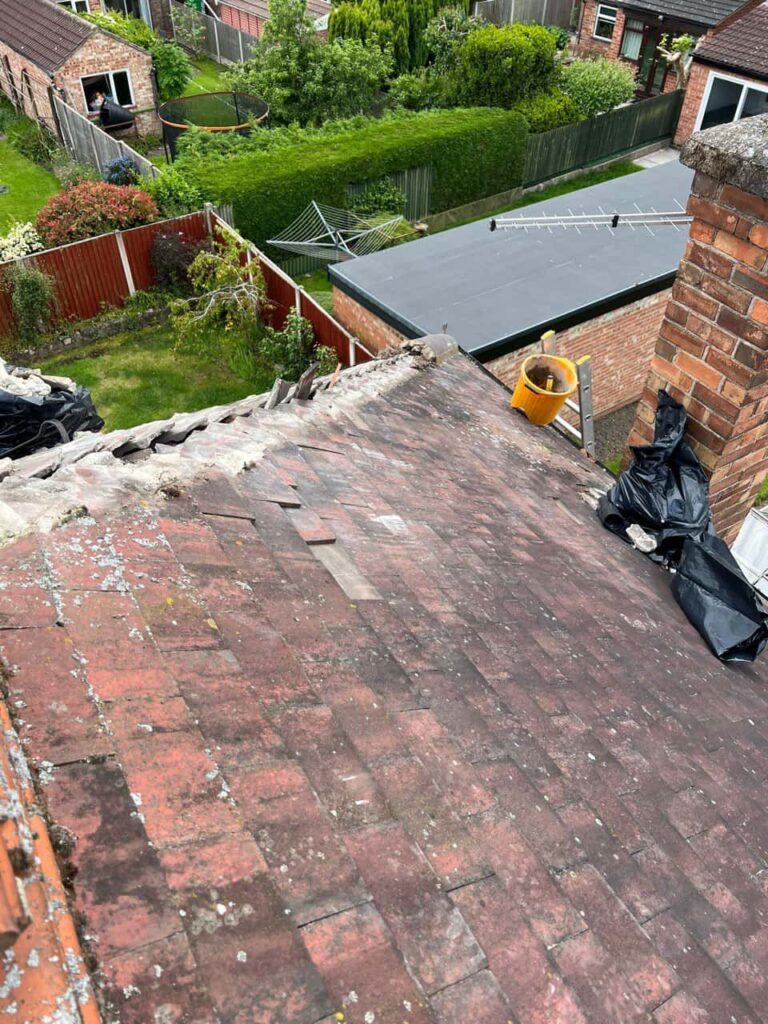Introduction
If you’ve noticed damp patches, water droplets, or even mould forming in your loft space, you’re not alone. Condensation in the loft is a common problem in UK homes — especially during the colder months when warm, moist indoor air rises and meets the cooler roof surfaces. While insulation and ventilation are often discussed in relation to this issue, one key component that’s frequently overlooked is the soffit.
At Newark on Trent Roofing Repairs, we’ve helped countless homeowners across Newark on Trent and Nottingham address persistent condensation issues in their lofts. And in many cases, faulty or blocked soffits have been a major contributing factor. In this article, we’ll explore how soffits play a vital role in roof ventilation, what happens when they fail, and how proper maintenance or replacement can make all the difference.
Understanding the Role of Soffits
Soffits are the boards tucked away under the eaves of your roof, bridging the gap between the wall and the roof edge. They may seem purely cosmetic, but they’re actually a key part of your roof’s ventilation system. Most modern soffits are designed with ventilation slots or are paired with additional venting systems to allow fresh air into the loft space.
Why soffits matter:
- They enable airflow into the loft, preventing moisture build-up
- Work in tandem with ridge or tile vents to promote circulation
- Help keep roof timbers dry and structurally sound
- Contribute to the overall energy efficiency of the home
When soffits are working properly, they allow cooler, drier air to enter the roof space, which in turn pushes out the warm, moist air — helping prevent condensation.
Signs That Soffits May Be Causing Loft Condensation
If your soffits are blocked, poorly installed, or damaged, the airflow into the loft is restricted. Without adequate ventilation, condensation forms when moist air becomes trapped. Over time, this leads to damage to insulation, timber rafters, and even ceilings below.
Common signs of soffit-related ventilation issues include:
- Damp patches on loft insulation
- Water droplets forming on roof membranes or rafters
- Mould growth on timber or stored items
- Musty smells in the loft space
- Visible signs of soffit damage or blocked vents from the outside
Even soffits that look fine from the ground may be blocked internally with debris, bird nests, or insulation pushed too tightly against the vents.
How Poor Ventilation Causes Condensation
Warm air naturally rises from the living areas of your home into the loft. This air carries moisture from cooking, bathing, and even breathing. If the loft space is cold — as it should be — that moisture condenses on cold surfaces like tiles, felt, or timbers.
Consequences of poor ventilation include:
- Rotting of timber beams and joists
- Degradation of insulation materials
- Mould and mildew, which can pose health risks
- Increased heating bills as insulation loses efficiency
Addressing ventilation is not just about preventing visible damp; it’s about protecting the long-term integrity of your home.
What Can Go Wrong With Soffits?
Soffits can fail to perform properly for several reasons, including age, poor materials, or inadequate installation. In some cases, the vents may never have been installed in the first place — particularly in older properties.
Typical soffit issues we encounter:
- No ventilation holes present
- Vents blocked by insulation or debris
- Cracked or rotten timber soffits
- Plastic soffits installed without airflow consideration
- Pest infestations blocking or damaging vents
At Newark on Trent Roofing Repairs, we often find that a simple inspection reveals these issues — and they’re frequently the root cause of recurring condensation problems.
The Solution: Improve or Replace Soffits
Once soffit-related ventilation issues have been identified, the next step is to restore proper airflow. This may involve unblocking vents, upgrading to ventilated soffits, or installing additional eaves ventilation systems.
Options for improving soffit ventilation:
- Replacing old timber soffits with modern uPVC ventilated boards
- Installing continuous eaves vents for consistent airflow
- Clearing insulation away from vents in the loft
- Repairing cracked or damaged panels to restore airflow
- Adding baffle trays to keep insulation away from the soffit area
Our team at Newark on Trent Roofing Repairs can assess your existing soffits and recommend the most effective, long-lasting solution based on your property’s layout and condition.
Conclusion
If you’re struggling with loft condensation, your soffits could very well be the missing piece of the puzzle. Proper ventilation is crucial to maintaining a dry, healthy roof space, and soffits play a central role in that system. Whether they’ve been damaged, poorly installed, or simply outdated, neglecting this part of your roof can lead to serious issues over time.
At Newark on Trent Roofing Repairs, we specialise in diagnosing and resolving soffit and roof ventilation problems throughout Newark on Trent and the surrounding Nottingham area. If you’ve noticed signs of damp or mould in your loft, don’t wait for it to worsen. Contact our expert team for an inspection and discover how targeted soffit improvements can restore balance and protect your home all year round.
Call us on: 01636 556 194
Click here to find out more about Newark on Trent Roofing Repairs
Click here to complete our contact form and see how we can help with your roofing needs.

